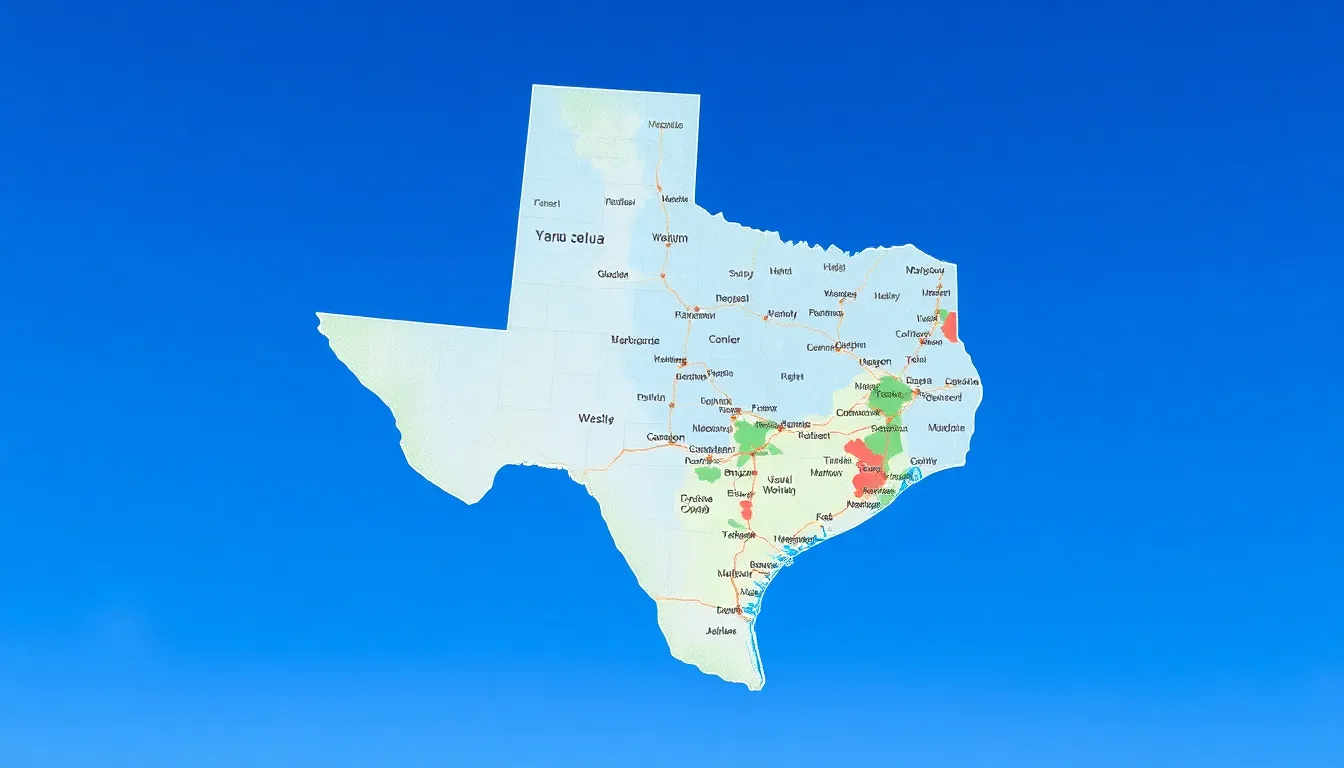Table of Contents
ToggleTexas, the Lone Star State, is as big as its reputation suggests. With sprawling landscapes, vibrant cities, and countless counties, navigating this vast territory can feel like trying to find a needle in a haystack—if that haystack was the size of a small country! Whether you’re planning a road trip to visit the iconic BBQ joints or hunting for the best Tex-Mex, a detailed map of Texas with its counties and cities is your trusty sidekick.
Overview of Texas Map With Counties and Cities
Texas features a complex map that showcases its counties and cities. This state has 254 counties, making it the state with the highest number in the U.S. Each county contains various cities and towns, contributing to the state’s diverse cultural landscape. Austin serves as the capital and is known for its vibrant music scene. Houston ranks as the largest city, followed by San Antonio and Dallas.
Navigating the Texas map offers insight into regional distinctions. For example, West Texas consists of vast deserts and small towns, while East Texas presents dense forests and numerous cities. The Texas Hill Country highlights rolling hills and wine regions, making it a popular destination for tourists. Knowledge of the map aids in understanding geographic relationships and travel routes.
Many online resources provide interactive maps with detailed information. Users can explore demographics, local attractions, and county outlines, all of which enhance travel planning. In addition, physical maps offer an alternative for those who prefer tangible navigation tools. Highways and major roads indicate transportation options across the state, making travel efficient.
Educational resources often utilize Texas maps to teach students about the state’s history and geography. Maps can illustrate important landmarks like the Alamo in San Antonio or the Space Center in Houston. Familiarity with the Texas map fosters a deeper connection to the state’s rich heritage and its people.
Importance of Texas Map With Counties and Cities

Texas maps with counties and cities play a crucial role for residents and visitors. Understanding the layout of the state provides insight into the cultural and geographic diversity Texas offers.
Historical Significance
Texas history is deeply intertwined with its geographical layout. Each of the 254 counties reflects a unique narrative of settlement, development, and historical events. Notably, maps help visualize the evolution of towns and cities from their origins to present-day locales. Recognizing these locations fosters an appreciation for Texas’s rich past, revealing stories of important figures and significant occurrences. Local museums and historical societies often utilize maps to educate people about landmarks that shaped the state’s identity. Ultimately, these resources enhance the understanding of historical context, linking the geography to its storied legacy.
Geographic Relevance
Geographic relevance of Texas maps cannot be overstated. The state’s vast size means that its diverse landscapes are represented through detailed county maps. Travelers benefit from maps illustrating various terrains, from deserts to forests, providing clues on activities and attractions. Major cities like Austin, Houston, and Dallas are easily identifiable, aiding in navigation and travel planning. Interactive maps reflect changing demographics and encourage exploration of hidden gems within each county. By highlighting transportation routes, these maps facilitate movement across large distances, ensuring travelers reach destinations efficiently. Geographically accurate maps enhance the experience of discovering Texas’s unique regional characteristics.
Features of Texas Map With Counties and Cities
Texas maps display intricate details that enhance navigation for both newcomers and longtime residents. These maps provide essential information on the 254 counties, showcasing the distinct characteristics of each region.
Detail Levels
Maps feature various detail levels, allowing users to zoom in on specific cities or counties. A closer view reveals streets, landmarks, and geographical features. Larger maps present an overview of Texas and illustrate the relationship between cities and rural areas. Travelers benefit from these details, which simplify route planning and ensure efficient travel throughout the vast state.
Color Coding
Color coding further enhances usability by distinguishing counties and cities. Each county appears in unique shades, making identification easy at a glance. Major cities like Houston and Dallas stand out due to bolder hues. This visual representation not only aids navigation but also highlights cultural distinctions across regions, enriching one’s understanding of Texas’s diversity.
Popular Resources for Texas Map With Counties and Cities
Finding accurate maps of Texas, including its counties and cities, is crucial for navigating the state. Several resources offer detailed information and tools to enhance travel planning.
Online Tools
Numerous websites provide interactive maps specifically highlighting Texas counties and cities. Users can access zoomable features that display streets, landmarks, and essential geographical details. Google Maps serves as a popular option, offering real-time traffic updates and route planning. Another useful tool, TexasMap.com, focuses on showcasing historical and cultural sites across the state. Additionally, GIS resources offered by state institutions present data on demographics, natural features, and planning services. Each of these online tools enables users to explore Texas based on specific interests, making navigation simpler and more informative.
Printed Maps
Printed maps offer a tangible way to explore Texas’s vast landscapes. Department of Transportation releases high-quality maps giving detailed overviews of travel routes and county lines. Visitors can also find local maps at visitor centers, showcasing attractions and cultural markers unique to each region. Specialty map retailers offer foldable, user-friendly editions for on-the-go navigation. Educational organizations distribute regional maps, emphasizing historical landmarks and cultural heritage. Exploring printed maps allows users to gain insight into local geography while enjoying the simplicity of offline access.
Navigating Texas requires more than just a sense of direction; it demands a reliable map that captures the state’s vastness and diversity. With 254 counties and numerous cities each offering unique experiences, a detailed map serves as an essential tool for both exploration and education. Whether it’s discovering hidden gems or understanding the rich cultural history, these maps provide invaluable insights. As travelers and residents alike utilize various resources for navigation, the journey through Texas becomes not just a trip but a deeper connection to the state’s heritage and landscapes. Embracing the power of Texas maps enhances the adventure, making every journey memorable and enriching.




